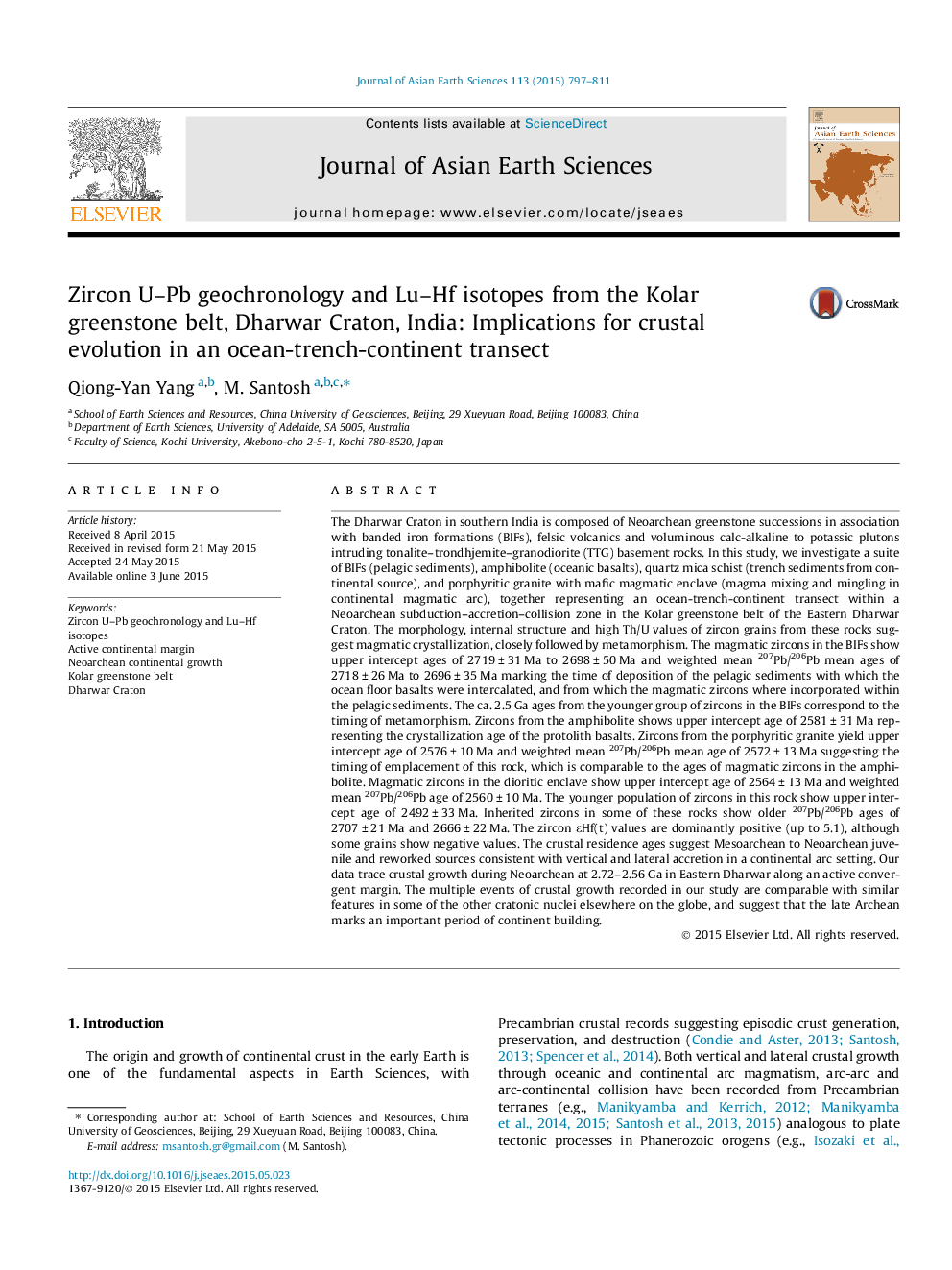| کد مقاله | کد نشریه | سال انتشار | مقاله انگلیسی | نسخه تمام متن |
|---|---|---|---|---|
| 4730332 | 1356749 | 2015 | 15 صفحه PDF | دانلود رایگان |

• Neoarchean ocean-trench-continent transect from Kolar greenstone belt.
• BIF deposition and submarine volcanism at 2.71–2.79 Ga.
• Magmatism in continental arc at 2.57 Ga with magma mixing and mingling.
• Multiple crustal growth during 2.7–2.5 Ga in Eastern Dharwar.
The Dharwar Craton in southern India is composed of Neoarchean greenstone successions in association with banded iron formations (BIFs), felsic volcanics and voluminous calc-alkaline to potassic plutons intruding tonalite–trondhjemite–granodiorite (TTG) basement rocks. In this study, we investigate a suite of BIFs (pelagic sediments), amphibolite (oceanic basalts), quartz mica schist (trench sediments from continental source), and porphyritic granite with mafic magmatic enclave (magma mixing and mingling in continental magmatic arc), together representing an ocean-trench-continent transect within a Neoarchean subduction–accretion–collision zone in the Kolar greenstone belt of the Eastern Dharwar Craton. The morphology, internal structure and high Th/U values of zircon grains from these rocks suggest magmatic crystallization, closely followed by metamorphism. The magmatic zircons in the BIFs show upper intercept ages of 2719 ± 31 Ma to 2698 ± 50 Ma and weighted mean 207Pb/206Pb mean ages of 2718 ± 26 Ma to 2696 ± 35 Ma marking the time of deposition of the pelagic sediments with which the ocean floor basalts were intercalated, and from which the magmatic zircons where incorporated within the pelagic sediments. The ca. 2.5 Ga ages from the younger group of zircons in the BIFs correspond to the timing of metamorphism. Zircons from the amphibolite shows upper intercept age of 2581 ± 31 Ma representing the crystallization age of the protolith basalts. Zircons from the porphyritic granite yield upper intercept age of 2576 ± 10 Ma and weighted mean 207Pb/206Pb mean age of 2572 ± 13 Ma suggesting the timing of emplacement of this rock, which is comparable to the ages of magmatic zircons in the amphibolite. Magmatic zircons in the dioritic enclave show upper intercept age of 2564 ± 13 Ma and weighted mean 207Pb/206Pb age of 2560 ± 10 Ma. The younger population of zircons in this rock show upper intercept age of 2492 ± 33 Ma. Inherited zircons in some of these rocks show older 207Pb/206Pb ages of 2707 ± 21 Ma and 2666 ± 22 Ma. The zircon εHf(t) values are dominantly positive (up to 5.1), although some grains show negative values. The crustal residence ages suggest Mesoarchean to Neoarchean juvenile and reworked sources consistent with vertical and lateral accretion in a continental arc setting. Our data trace crustal growth during Neoarchean at 2.72–2.56 Ga in Eastern Dharwar along an active convergent margin. The multiple events of crustal growth recorded in our study are comparable with similar features in some of the other cratonic nuclei elsewhere on the globe, and suggest that the late Archean marks an important period of continent building.
Figure optionsDownload as PowerPoint slide
Journal: Journal of Asian Earth Sciences - Volume 113, Part 2, 1 December 2015, Pages 797–811